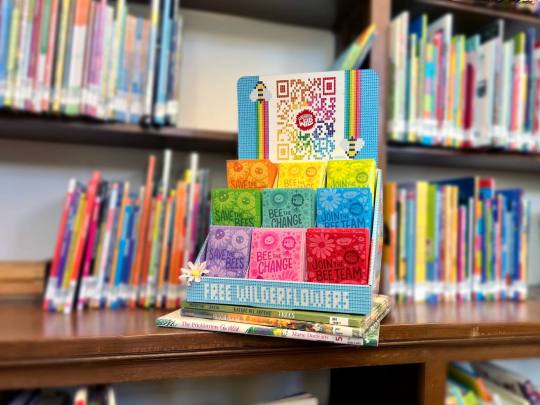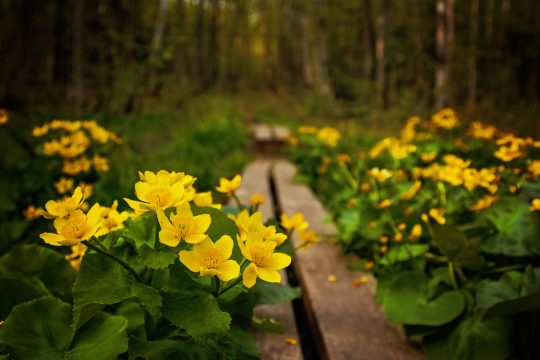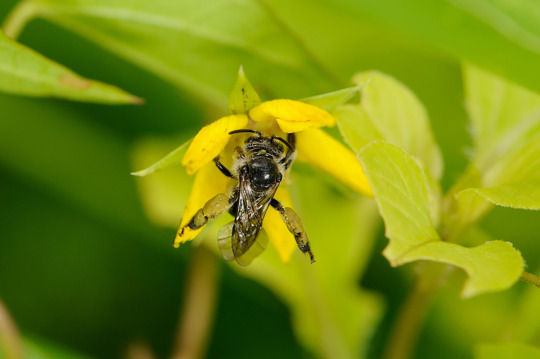#Pollination Ecology
Explore tagged Tumblr posts
Text
The way worker bees cap the baby larvae cells decides their gender and future role in the hive
#Bee Larvae#Gender Determination#Honeybee Colony#Insect Genetics#Bee Behavior#Hive Structure#Haploid vs Diploid#Honeybee Research#Queen Bee#Colony Behavior#Hymenoptera Sex Determination#Gene Regulation#Honeybee Robotics#Pollination Ecology#Hive Technology#Bio-hybrid Entities#gender role#Queen bee cell#Drone bee#Worker bee#Insect facts#interesting facts videos
1 note
·
View note
Text
A caveat to this study: the researchers were primarily looking at insect pollinator biodiversity. Planting a few native wildflowers in your garden will not suddenly cause unusual megafauna from the surrounding hinterlands to crowd onto your porch.
That being said, this study backs up Douglas Tallamy's optimistic vision of Homegrown National Park, which calls for people in communities of all sizes to dedicate some of their yard (or porch or balcony) to native plants. This creates a patchwork of microhabitats that can support more mobile insect life and other small beings, which is particularly crucial in areas where habitat fragmentation is severe. This patchwork can create migration corridors, at least for smaller, very mobile species, between larger areas of habitat that were previously cut off from each other.
It may not seem like much to have a few pots of native flowers on your tiny little balcony compared to someone who can rewild acres of land, but it makes more of a difference than you may realize. You may just be creating a place where a pollinating insect flying by can get some nectar, or lay her eggs. Moreover, by planting native species you're showing your neighbors these plants can be just as beautiful as non-native ornamentals, and they may follow suit.
In a time when habitat loss is the single biggest cause of species endangerment and extinction, every bit of native habitat restored makes a difference.
#nature#wildlife#animals#ecology#environment#conservation#science#scicomm#pollinators#bees#butterflies#hoverflies#insects#native plants#habitat restoration#solarpunk#hopepunk#naturecore#wildflowers#good news
414 notes
·
View notes
Text
Bacteria that live in soil and help roots fix nitrogen can boost certain plants' capacity to reproduce, according to an article published in the American Journal of Botany describing a study of this mechanism in Chamaecrista latistipula, a legume belonging to the Fabaceae family, which includes beans and peas. Bacteria in the soil enhance the attractiveness of the plant's flowers to pollinators via a type of relationship known as mutualism that is widespread in plants and animals. Microorganisms such as bacteria or fungi contribute to and benefit from mutualistic relationships with plants, whereby both sides obtain more nutrients or reproduce more vigorously, for example.
Continue Reading.
#Science#Plants#Biology#Botany#Ecology#Bacteria#Mutualism#Legume#Chamaecrista Latistipula#Pollination
546 notes
·
View notes
Text
"Next Monday [6/17/24] is the start of National Pollinator Awareness Week, and one Colorado advocacy group is hosting a flower planting drive to rewild Colorado’s meadows, gardens, and just maybe, its children too.
Created by constitutional amendment in 1992, Great Outdoors Colorado (GOCO) is a state-funded independent board that invests a portion of Colorado Lottery proceeds to help preserve and enhance the state’s parks, trails, wildlife, rivers, and open spaces.
This year, GOCO’s offshoot Generation Wild is distributing over 100,000 free packets of wildflower seeds to collection points at museums, Denver Parks and Rec. offices, and libraries all over the state to encourage kids and families to plant the seeds in their backyards.
The Save the Bees! initiative aims to make the state more beautiful, more ecologically diverse, and more friendly to pollinators.
According to a new report from the Colorado Department of Natural Resources, 20% of Colorado’s bumblebees are now at risk of extinction. Even in a small area like a backyard, planting wildflowers can make a positive impact on the local ecosystem and provide native bees with a healthy place to live.
“The Western Bumblebee population has declined in Colorado by 72%, and we’re calling on kids across Colorado to ‘bee’ the change,” said GOCO Executive Director Jackie Miller.

Named after Generation Wild’s official mascot “Wilder,” the Wilderflower Seed Mix was developed in partnership with Applewood Seed Co. and packets are now available for pickup at designated partner sites including more than 80 Little Free Library boxes.
By distributing 100,000 Wilderflower packets, Generation Wild is providing more than 56 million seeds for planting in every nook and cranny of the state. All seeds are regionally-native to Colorado, which is important for sustaining the living landscape of bees, birds, and other animals.
Additionally, by using flower species adapted to the Mile High climate, landscapers and gardeners need to use less water than if they were tending non-native plants.
“Applewood Seed Co. was excited to jump in and help Generation Wild identify a seed mix that is native to the Colorado region and the American West, containing a diversity of flower species to attract and support Colorado’s pollinator populations,” stated Norm Poppe, CEO of Applewood Seed Co. “We hope efforts like this continue to educate the public on pollinator conservation and the need to protect our native bees and butterflies.”
Concluding her statement Miller firmly stated that children grow up better outside, and if you or a parent you know agree with her, all the information on how to participate in Save the Bees! can be found here on their website, including a map showing all the local pickup points for the Wilderflower Seed Packets."
-via Good News Network, June 13, 2024
#wildflowers#wild flowers#colorado#bees#native bees#entomology#insects#save the bees#pollinators#bumblebees#bumble bee#i love bees#biodiversity#native plants#urban gardening#gardening#ecology#conservation#endangered species#wildlife conservation#enviromentalism#good news#hope#hope posting#solarpunk#denver#boulder colorado#colorado springs#libraries#public libraries
481 notes
·
View notes
Text

kill your lawn save the pollinators
made in 2022
#kill your lawn#save the pollinators#save the bees#monarch#monarch butterfly#bugblr#bug art#milkweed#flower art#ecology#nature art#artists on tumblr#block print#block printing#linoprint#linocarving#linocut print#linocut#printmaker#printmaking#small artist#traditional art#traditional printing#traditional printmaking#original art#lesbian artist#butch artist#trans artist#pollinators#animal art
138 notes
·
View notes
Text



Tropical Milkweed—a No-Grow
Milkweed is in demand, and that demand has been filled in recent years by tropical milkweed, a non-native species.
But is planting tropical milkweed potentially doing more harm than good?
Tropical milkweed (Asclepias curassavica) is a non-native milkweed that has exploded in popularity in response to the demand for milkweed. It is simple to propagate, allowing growers to rapidly produce the plant for quick sale. The plant is also attractive, both to humans and monarchs, providing flowers and lush green foliage throughout the growing season – and that’s a problem. Tropical milkweed becomes a problem when planted in temperate areas where it does not die back in winter. A protozoan parasite of monarch butterflies, Ophryocystis elektroscirrha or OE for short, can travel with monarchs visiting the plants and become deposited on leaves. When caterpillars hatch and start eating the plant, they ingest the OE. High OE levels in adult monarchs have been linked to lower migration success in the eastern monarch population, as well as reductions in body mass, lifespan, mating success, and flight ability. When native milkweeds die back after blooming, the parasite dies along with them so that each summer’s monarch population feeds on fresh, parasite-free foliage...
Read more:
https://xerces.org/blog/tropical-milkweed-a-no-grow
#ecology#monarch butterfly#butterfly#pollinators#migration#animals#nature#science#pollination#north america#lepidoptera#insect#entomology#gardens#gardening#plants
140 notes
·
View notes
Text

Fly feeding on nectar and/or pollen. I very often see more flies on flowers than Hymenoptera (bees, wasps, etc) or Lepidoptera (butterflies and moths). Let's save not just the bees, but all the bugs, regardless of how they look <3 (with exceptions when it comes to public health, invasive species, agriculture, etc) Species unknown, superfamily Oestroidea Northeastern Pennsylvania, US
#flies are cool#diptera#pollinator#flies#entomology#bugs#nature photography#biodiversity#animals#bugblr#inaturalist#insect appreciation#arthropods#macro photography#macro#pink#flower#creature#invertebrates#invertiblr#ecology#support native pollinators#nature#Oestroidea
26 notes
·
View notes
Text

Marsh Marigold (Caltha Palustris)
Despite bearing "Marigold" in its name, this plant is no Marigold at all, but a buttercup, a trickster of a bloom that dances between identities, although these identities are purely social constructs that we have provided for it. Its scientific name, Caltha palustris, is a phrase that feels less like a word to speak and more like a secret to whisper, a charm carried on the tongue, delicate and fleeting. Try saying it out loud and you'll know what I mean.
Every part of the plant holds a quiet danger; its leaves, stems, and roots are poisonous unless boiled three, even four times, as if its secrets must be coaxed out with patience and fire. Its heart-shaped leaves hug the earth, while its rhizome roots anchor it to worlds unseen, a world inundated and saturated with water and soil. Five golden petals glimmer like drops of stolen sunlight, and its nectar, a banquet for those brave bees who awaken early from their winter torpor, seems almost an offering, a bargain struck between poison for us humans and susitenance for the pollinators.
True to its name, the Marsh Marigold thrives in waterlogged soil, its feet firmly planted in mud and mire, as though it belongs to a story of wetlands and whispered promises, a flower that knows the weight of water and the power of resilience.
7 notes
·
View notes
Text


16 notes
·
View notes
Text
sphinx moth (Hyles sp.) visiting a population of unusually pink snowball sand verbena (Abronia fragrans)
these guys are also called hummingbird moths (for obvious reasons)
92 notes
·
View notes
Text
Another Year of Pollination: Pollenkitt
Pollination in flowering plants is the process of moving pollen grains, which carry sperm cells, from the anthers to the stigmas of either the same flower or a separate flower. If things go well from there, sperm cells will be transported via pollen tubes into the ovaries where fertilization with egg cells can take place and seeds can form. Pollen grain development occurs within the anthers, and…

View On WordPress
#animal pollination#bees#Botany#floral anatomy#flowers#insect pollination#plant ecology#plant science research#pollen#pollen grains#pollenkitt#pollination#pollinators#wind pollination#year of pollination
18 notes
·
View notes
Text
The shape of the bee larvae capped cell determines their gender role
The shape of the honey bee larvae 🐝 cell capping, determines their gender and role in the hive. Cell capping is a unique process that worker bees use to produce drone bees, worker bees, and a new queen for the hive.
#Bee Larvae#Gender Determination#Honeybee Colony#Insect Genetics#Bee Behavior#Hive Structure#Haploid vs Diploid#Honeybee Research#Queen Bee#Colony Behavior#Hymenoptera Sex Determination#Gene Regulation#Honeybee Robotics#Pollination Ecology#Hive Technology#Bio-hybrid Entities#gender role#Queen bee cell#Drone bee#Worker bee#Insect facts#interesting facts videos
0 notes
Text

Xerces Society: Announcing The State Of The Bees Initiative: Our Plan To Study Every Wild Bee Species In The U.S.
This is really exciting news! For those unaware, the Xerces Society has been focusing on invertebrate conservation for over fifty years, and has pioneered a lot of the work to bring awareness to the devastating losses of not only insects but other terrestrial and aquatic invertebrates. It gets its name from the Xerces blue butterfly (Glaucopsyche xerces), the first North American butterfly driven to extinction by human activities.
Even if you haven't heard of the Xerces Society, you've probably come across various "Save the Bees!" campaigns. These frequently focus on the domesticated European honey bee (Apis mellifera), which, while it may be important to crop pollination in many parts of the world, is not a part of natural ecosystems in places like the Americas and Australia, and can be considered an invasive species at times. With the rise of colony collapse disorder (CCD) particularly after the turn of the 21st century, where entire domestic honeybee colonies would die off, the need to preserve bees began to gain wider public acknowledgement.
But what many people don't realize is that it is the thousands upon thousands of other native bee species worldwide that are in greater danger of extinction. They don't have armies of beekeepers giving them safe places to live and treating them for diseases and parasites. More importantly, where honey bees may visit a wide variety of plants, native bees often have a much narrower series of species they visit, and they are quite vulnerable to habitat loss. Most bees are not as social as honey bees and live solitary lives, unseen by the casual observer.
Invertebrates in general often suffer from a lack of conservation information, meaning that particularly vulnerable species may fly under the radar and risk going extinct without anyone realizing until it's too late. This ambitious program by the Xerces Society aims to solve that problem, at least for the 3,600+ species of bee in the United States. If they can assign a conservation status to each one, then that strengthens the argument toward protecting their wild habitats and working to increase their numbers. Hopefully it will also prompt more attention to other under-studied species that are in danger of going extinct simply because we don't know enough about them.
#bees#save the bees#invertebrates#arthropods#insects#entomology#nature#wildlife#animals#ecology#environment#conservation#science#scicomm#endangered species#extinction#pollinators#Xerces Society#Xerces blue
598 notes
·
View notes
Link
The researchers evaluated the national "Operation: Save the Bees" campaign, and their results indicate that what private individuals do in their gardens really can make a positive difference.
The fact that pollinating insects are crucial for the functioning of ecosystems and food supply is well known. However, many pollinating species are endangered or in decline.
In 2018, The Swedish Society for Nature Conservation launched a campaign to save bees and other pollinators, aiming to get the public involved by creating more favorable environments in private gardens. The actions that were encouraged were to create a meadow, plant flowers or set up a bee hotel. Around 11,000 Swedes responded to the call, and now researchers from Lund University have evaluated the measures.
"We wanted to investigate measures that the public themselves chose to implement in their garden, and how these can be the most efficient," says Anna Persson, researcher at Lund University and one of the people behind the study.
Continue Reading
234 notes
·
View notes
Text
Plant of the week: yarrow (Achillea millefolium)

Sun: full sun to part shade
Soil: average to dry
Bloom: april-september
This licorice scented plant has some pretty neat medicinal value! Used by indigenous peoples for ear, tooth, and headache, it also has blood clotting properties that can stop bleeding! Due to this it should NOT be used with blood thinners!
Its a plant thats able to grow in nutritionally poor soil and spreads aggressively in disturbed areas without dense planting, and spreads by rizomes. It does have non native varieties which has lead me to deeper research on this topic. Long story short; theres many sub species in this family all listed under the same name, varying on where you are in the states. East coast yours will be more closely related to european yarrow, and west coast asian. I have yet to find much of a guide on how to tell the differences, but that may change! There may also be cross breeding between the native and non native varieties further making the differences muddied. Bottom line is: if you plan on adding this to your garden get from local native nurseries so you have your regions ecotype. The brightly colored ones are typically cultivars and i would personally avoid due to my purist mindset on this stuff.
Overall, not a lot of wildlife value, though good for pollinators and acts as a host plant for some species including the yarrow plume moth and painted lady butterfly, but i have yet to see a specific list on the other "several caterpillars". According to https://www.northeastpollinator.com/products/achillea-millefolium-yarrow?variant=40450926248045 it also hosts some specialist bees such as the cinquefoil masked bee, and the sanicle masked bee! Birds also enjoy the leaves for nest building!



6 notes
·
View notes
Text
A beautiful evening brown butterfly outside my door; those spots are false eyes to ward off predators.

#blogger#biodiversity#photography#my photos#photooftheday#butterfly#butterflies#biodiversity conservation#biodiversity preservation#ecology#ecosystem#pollinators#pollination
5 notes
·
View notes